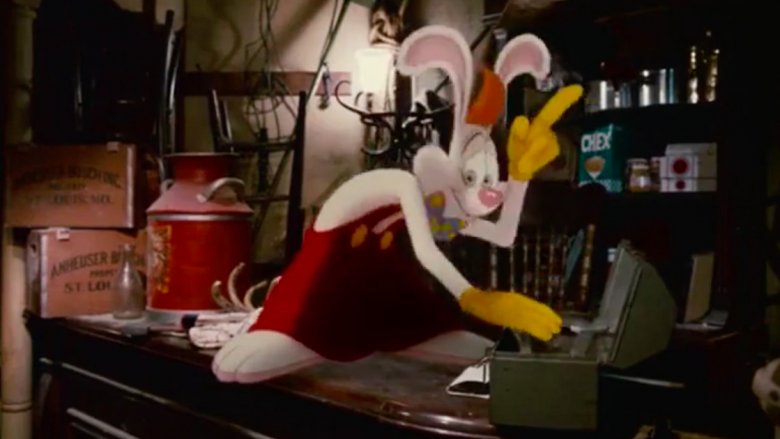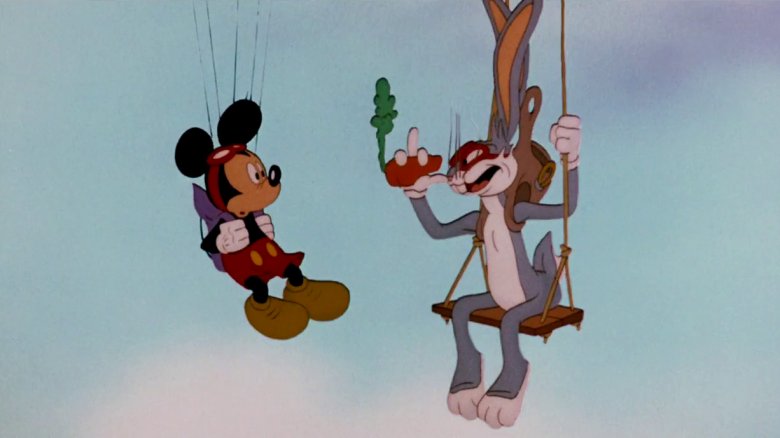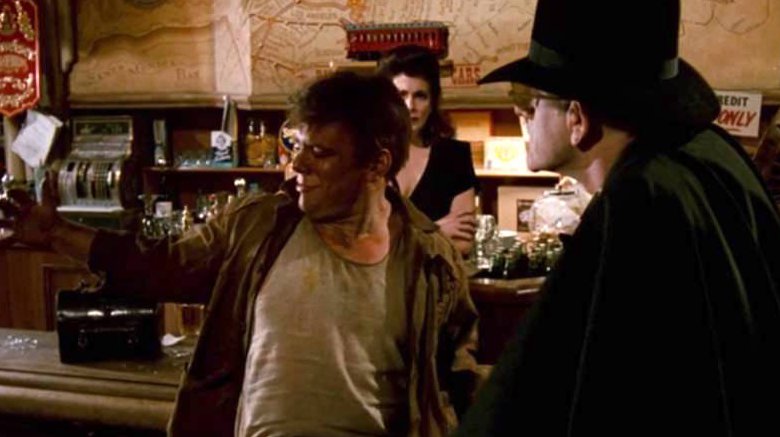Things About Who Framed Roger Rabbit You Only Notice As An Adult
You may remember Who Framed Roger Rabbit as a beloved animated film from your childhood, but upon viewing it as an adult, you might be shocked at its marked explicit content. The movie is actually based on a 1981 novel by Gary K. Wolf, Who Censored Roger Rabbit. Though the noir elements are there, the book takes place in the present day where people and toons co-exist, whereas the movie takes place in 1947 Los Angeles, where the toons are segregated in "toon town."
From the movie's colorful language, to its varied pop culture references, to the bodacious Jessica Rabbit, here are some fascinating things about Who Framed Roger Rabbit you only notice as an adult.
Baby Herman is a sexual predator
Baby Herman might look sweet, but that's just a part he plays in the movies; Herman is a total perv. As he tells Eddie, "I've got a 50-year-old's lust and a three-year-old's dinky." When we first meet him, he's looking up a female crew member's skirt. In the theatrical release, Baby Herman was actually pointing up towards the woman's crotch (some viewers say, with his middle finger) but this was cut from the DVD release. When Herman goes to see Eddie, he slaps his lady friend on the butt. As kids we may have known something wasn't right about a cartoon baby smoking a giant cigar, but the sexual predilections of Baby Herman may have gone over our innocent little heads.
Pattycake, pattycake!
When Eddie captures Jessica Rabbit and Marvin Acme playing "pattycake" in her dressing room, he thinks he's struck gold to convince Roger that his wife is cheating on him. But the joke's on Eddie, and on us—when the pictures are revealed that Jessica and Marvin are in actuality playing pattycake, not engaging in a sexual act, as insinuated by the scene. Whether or not pattycake is the toon equivalent of sex, if you were under the age of 15 when you saw this movie, hopefully the entire bit would've been lost on you.
Jessica Rabbit has a Basic Instinct moment
As she says, Jessica Rabbit "isn't bad, she's just drawn that way." But her voluptuous curves seem to get her into serious trouble and it seems like she's constantly having to convince everyone that her and Roger's love is for real. It happens in the blink of an eye, but in the end of the film, when Jessica and Eddie are in a high speed chase and thrown from the taxi, there's a moment her thigh-high split dress fails her and she flashes the camera, much to the delight of toons and humans alike. Some claim if you slow down the frame-rate it's obvious that Jessica's not wearing any underwear.
Jessica Rabbit's curves also come in handy—pun intended—when the weasels try to frisk her at the Acme factory. Eddie says, "nice booby trap," thus confusing young viewers forever on the true meaning of the term.
The effects of alcoholism
Eddie Valiant spends much of the movie in Dolores' bar, and when he's not there, he's at home in his office, drowning his sorrows. Eddie's brother, who was also his partner, was killed by a toon, and it's obvious that Eddie is self-medicating his pain with the help of booze. (A fun anecdote: when Eddie orders his drink "on the rocks" in the club, the penguin-waiters—get it?—bring him a glass with actual rocks inside it.)
Watching the movie as an adult, it's obvious that Eddie is a full-blown alcoholic. But the movie tries to warn its younger audience members about the dangers of alcohol. When Roger is given a drink after discovering Jessica's infidelity, he literally loses his head.
Problem with your probate
In the scene where Eddie and Roger are trying to get the handcuffs off, Eddie suggests that Dolores go downtown to check the probate on Acme's will. "Oh, my uncle Thumper had a problem with his probate and he had to take big pills and drink lots of water!" Roger exclaims. "Not prostate, you idiot, probate," Eddie corrects him. Chances are you had no idea what a prostate was when you were a kid. Apparently neither does Roger. Prostate, probate, let's call the whole thing off.
Bugs Bunny flips the bird
Despite the fact that it was distributed by Touchstone Pictures, the film distribution label of Walt Disney Pictures, Disney was very particular about the way its classic cartoons were depicted on screen. Though Roger Rabbit is clearly based on the character of Bugs Bunny, who belongs to Warner Brothers, he is decidedly his own rabbit—a very different bunny. That said, the animators wanted to include some classic cartoon characters, like Mickey Mouse and Bugs Bunny. Warner Brothers would only agree to Bugs' appearance in the film if he got the same amount of screen time as Mickey.
So, Mickey and Bugs appear together, only briefly in the scene where Eddie falls from the skyscraper in toon town. After giving Eddie the "spare," which turns out to be a spare tire, not a spare parachute, Bugs says to Mickey, "Ain't I a stinker?" and twiddles his fingers. If you pause the movie at the right time, you'll catch a single frame of Bugs flipping the bird. Fans of the film have theorized it might have been the animators way of saying piss off to Warner Brothers and Disney and their demands over the way their star cartoons were depicted in the movie.
Christopher Lloyd's inhuman performance
The infamous shoe-melting scene in Who Framed Roger Rabbit is one of the most traumatic cinematic moments of our childhood. (Seriously, watch at your own risk, because it's still too difficult for us to watch.) Thanks to Christopher Lloyd's terrifying performance, Judge Doom goes down in the history books as one of the scariest movie villains ever. Of course he has some help from special effects at the end of the movie, but hardcore fans of the film may have noticed that Lloyd does something inhuman in every scene he appears in—he never blinks. Terrifying.
Harvey the invisible rabbit
When Judge Doom storms the bar looking for Roger, one of the patrons says, "he's right here—say hello, Harvey," indicating an invisible rabbit. The younger generation of audience members probably missed out on the reference is to Harvey, a 1950 comedy starring Jimmy Stewart about an invisible rabbit.
The chronology of this reference is a bit mixed-up, considering the movie didn't premiere until three years after Roger Rabbit is supposed to take place, but you could argue that it's based on Mary Kay Harvey's play of the same title, which was written in 1944. And it just so happens that the main character in the movie and play, Elwood P. Dowd, is an alcoholic (like Eddie) and a cartoonist, just to make the reference even more complex.
Singing Sword is Frank Sinatra
Looking for a weapon in the final show-off with Judge Doom, Eddie grabs a prop out of a box in the warehouse, the singing sword. Eddie's namesake, Valiant, is a reference to the Prince Valiant cartoon of the late 1930s and 40s—in it, Prince Valiant's weapon of choice is... you guessed it, a singing sword named Flamberge.
But that's not the only pop culture reference packed into this short bit at the end of the film. This singing sword is none other than Frank Sinatra, a.k.a. "Old Blue Eyes." While baby boomers will certainly recognize the young Sinatra, the younger generation might have had difficulty identifying the face and tune. (It's "Witchcraft," by the way.)
References to racism in Hollywood
As R.K. Maroon says in one of the first scenes of the film, "they work for peanuts." He's talking about Dumbo, but it's one of the many signals that the movie could be a metaphor for racism in Hollywood. "For anyone who read the book Who Censored Roger Rabbit (which the film was based on), this is no surprise," Julia Gazdag wrote for Hello Giggles.
The toons work as performers, but at the club where Jessica performs humans are the only patrons, like popular clubs of the period that only allowed white audiences for performances featuring black entertainers. "Toons are second class citizens, despite their status in the public eye," Gazdag continued. "It's like when Sammy Davis Jr. headlined in Vegas, but couldn't eat or gamble at the Casino he was playing, and had to stay at a separate (sh*ttier) hotel across town."
Then there's Judge Doom, who Gazdag posits "attained his position of power by disguising his heritage and literally turning from a colored character into a white male," and Jessica Rabbit, whose line "I'm not bad, I'm just drawn that way," might as well be saying, "that she's not robbing your store, she's just wearing a hoodie, or that she's not doing anything illegal, she's just driving a car."
In the end, Roger Rabbit's achievements in animation are only bolstered by this extended metaphor on racism and segregation. It's fascinating to re-watch the movie as an adult while keeping this metaphor in mind.


